GURPS Lensman by Nessus
Clear ether!
Original SA postClear ether!
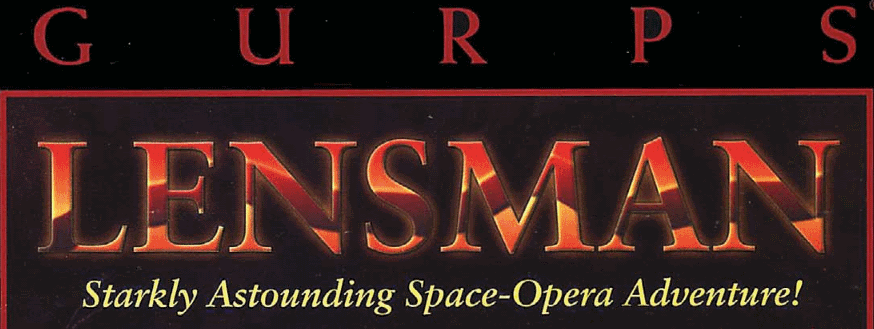
The Lensman series consists of seven novels written in a chronologically inconsistent order: Galactic Patrol, Gray Lensman, Second Stage Lensman and Children of the Lens, all of which were serialized in Astounding Stories magazine from 1937 through 1948. The author, E.E. "Doc" Smith, rewrote an earlier work (Triplanetary) to serve as a prequel and wrote a bridging novel, First Lensman, revising the rest of the work to be more internally consistent in 1954. Smith wrote another novel, The Vortex Blaster, in 1960. There were also three authorized side-novels by David Kyle (The Dragon Lensman, Lensman from Rigel, and Z-Lensman). There was also some anime - a movie and a two-season TV show, apparently not widely regarded.
https://www.youtube.com/watch?v=RBod6EKQaok
The Lensman series has been tremendously influential, and is the progenitor of the entire "space opera" genre. I don't say "a" on purpose. Essentially everything in that field starts here in some form. The US Navy deliberately modeled their combat information centers on a hypothetical command ship Smith invented; power armor, intergalactic travel, and bizarre aliens that are nonetheless relatable despite spectacularly inhuman psychologies are common. As is the power creep. Thankfully enough the novels end not long after the point where they are using exotic-matter inertialess planets operating at multiple times light speed as kinetic kill weapons, but they get there from "Take this tractor-beam warship and try to figure out what the space pirates are using for power."
GURPS Lensman was written and published in 1993 by Sean Barrett. It is not available for retail or PDF sale at present, although you can probably get it secondhand - which is also where you would need to get the Lensman books. I have a complete set and have enjoyed them, but the books have issues - Kyle's books clean up a lot of it, and much of it was likely rooted in ignorance or apathy (a la Howard) rather than fear of a black planet (a la Lovecraft). The GURPS book does not do anything particularly new or imaginative with the material - it simply collates it and reifies it. Nonetheless, there are ideas here that may bear fruit seen in the light of modern day.
I. Introduction, history and society
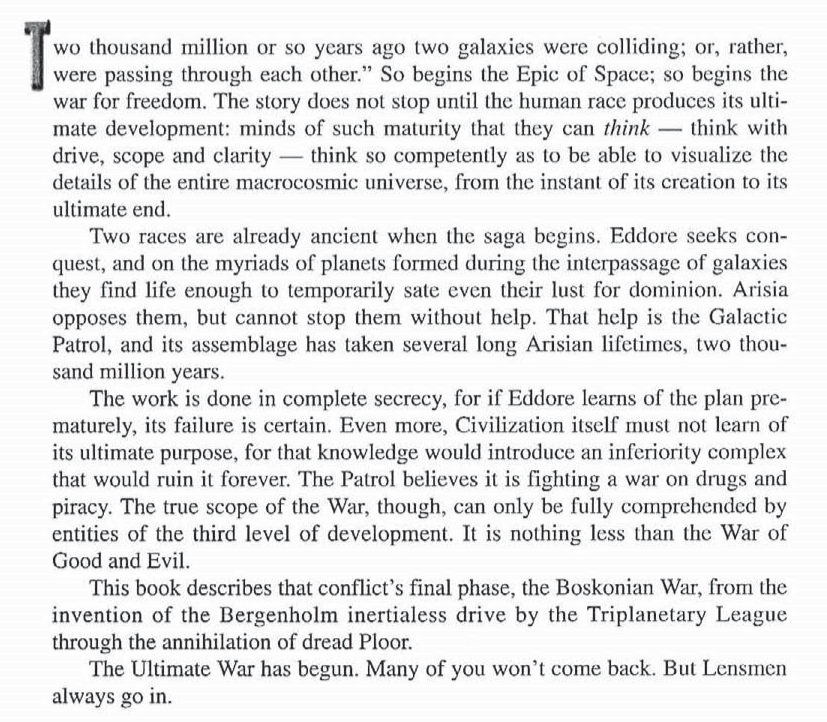
no pressure or nothing
So, that's the setting. The Arisians are presented as assholes with ultimately good intentions, while the Eddorians do pretty much everything evil in order to satisfy a fundamental lust for power existing for its own sake. These are cartoon sketches, even if perhaps the same recent history that makes things like Sufficiently Advanced seem overly naive also makes the Eddorians more plausible.
The setting history is summarized in a couple of pages, including a cute aside suggesting Arisian interference to prevent the development of transistor electronics on Earth. (Civilization's electronics - and apparently that of their enemies - runs on extremely refined vacuum tubes, about which more later.) The big divergence point is the Cuban missile crisis going hot due to a radar failure, at which point Earth crawls back up and lurches into space. This appears to be the work of Sean Barrett; the entire Lensman corpus was written by the time of the missile crisis.
One of the premises of the setting is that intelligent life is extremely common, with seal-like people on Venus (which is, of course, a tropical hothouse, not what it is now) and slow-moving estivated guys on Mars. There are also squat supermen on Jupiter, though that's where it ends. The plot involves a lot of desperate fights and spy-novel thriller chases. When a guy named Bergenholm creates a fast interstellar drive, law enforcement breaks down, and the titular First Lensman goes to Arisia to get the Lens as a tool for law enforcement.
The Lens is presented as an unforgeable identifier, a universal translator, and (for humans) a telepathic enhancer. Getting a Lens requires you to pass muster with the super-brains on Arisia -- and it is explicitly noted that some number of people who make it through the Earth academy system that produces Lensmen candidates go to Arisia and do not return. Other planets do things their own way, and it is offhandedly mentioned that most of the point of the academy system is to improve the prospective Lensman and the jillions of candidates who wash out, because the Lensmen themselves could spot out "Lensman material" among babies in the crib.
In GURPS terms being a Lensman is a 100-point Advantage with a bunch of requirements. Summarized:
* Officer (Rank 4+) in the Galactic Patrol
* Sex restrictions depending on species (see next update)
* The nastier Mental Disadvantages (Bully, Sadism, Pyromania, etc.) are a no-go. If you have a "Split Personality" all the components have to meet the requirements. Secrets are variable - Mentor of Arisia will learn 'em, so GM's option.
* Honesty, the "Lensman's Load" Code of Honor, and Sense of Duty (Civilization) are required.
* Also, you need a little bit of Telepathy power. Implicitly you just need to not NOT have telepathy, rather than formal Power.
* You get to have Enemy (Boskonia) as a result. ("Boskonia" is the umbrella term for The Bad Guys, since "Eddore" is a massive in-universe secret.)
The benefits are significant. You get the Judge Dredd level of Legal Enforcement Powers - Lensmen are able to judge, jury, and execute at their discretion without criticism or oversight. The Lens also gives you 50 points to blow on various mental advantages. Humans have to buy up telepathy powers and skill, while the three other main alien races mostly enhance their native Telepathy and buy off Weak Will/buy up Strong Will. These points are tracked separately from others: if Lensman Jackoff buys Telepathy Power 8 with 40 of these points, then spends 10 more points buying up to Power 10, he has Power 2 when he takes off his Lens.
The "unforgable ID" part of a Lens comes from its status as some kind of psionic crystal. Each one is made by the Arisians and sparkles gorgeously when in contact with the appointed bearer. The Lens disappears shortly after its bearer dies. When not in contact with its bearer it looks dull and grey and will do 3d of damage per second to anyone touching it. (For context, the average human has 10 HP in GURPS.) Humans usually put theirs in a bracelet; sturdier aliens may get them mounted internally.
The "Universal Translator" is genuinely universal: a Lensman can understand any meaningful communication they can perceive. Concepts may not transfer if they are really alien, and a Lensman can't pick up radio transmissions without a receiver (or an organic ability to do so...) but no code is safe. It is interesting to consider if this would apply to steganography.
Most Lensmen are officers in the Galactic Patrol and either die in the saddle or move into staff positions - often due to severe injury that they manage to survive. Some Lensmen, due to long experience and successful missions, are given the "Release" - no, not that kind of release; essentially, they are completely freed from the requirements of the hierarchy and are bound only by their own conscience. These "Gray Lensmen" also become the specific personal enemy of Boskonia, which will now appear "almost all the time." A consolation here is that Gray Lensmen effectively have unlimited wealth - they can requisition essentially anything and the Galactic Patrol will pay for it.
So, those are the Lensmen. Horrifying, aren't they? You can see where they got the idea for the Psi-Corps. Or the Jedi, or the Green Lantern Corps...
In anything resembling actual reality they would be the true masters of their host culture. And this is honestly more or less the case in the books, which we will touch on when we start talking about planetary civilizations. The interior story-logic is that the Lensmen are actually incorruptible, and genuinely believe in their ethics. Presumably the Arisians test every prospective Lensman and if they find that they would break under pressure that wouldn't kill them, or who gamed the system to get in, they cut to the chase and kill them themselves. The situation is also buttressed by the First Lensman and his OG buddies taking down a corrupt political machine in North America connected to space pirates and criminals (how topical!), which gave them enough credibility to earn societal tolerance.
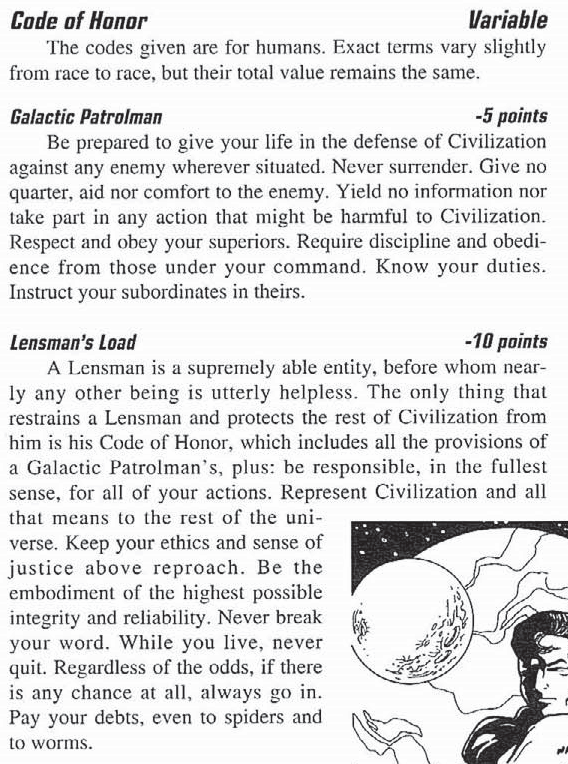
Our next update will be about sexism.
Sexism, Society and Some Aliens
Original SA postYou can't have a seven-sector call out without calling something out:

II. Sexism, Society and Some Aliens
First, the sexist horse in the starkly inconcievable stall.
The original Lensmen books associated Lenses with male officers of the Galactic Patrol - at least as far as humans went. A human woman did become a Lensman in the story, as did her female descendants. The bad guys also later figured out how to kind-of make Lenses and recruited near-human alien women as their own Lensmen. In "First Lensmen," written in the fifties, Smith had the Arisians (gently) turn a tough, able human woman down from Lensmanship.
GURPS Lensmen leans into this with several tiers of excuses.
In-universe, "Lenses are as masculine as whiskers" (to quote Jill Samms, the woman who was turned down) and some justification boiling down to "a population can bounce back from losing a lot of men faster than losing a lot of women." The former does exist in the books while the latter, I believe, does not arise, and David Kyle's authorized sequels have a female Lensman of an essentially human species.
Out of universe, the book defends Doc Smith from charges of being a sexist. (He certainly was not an active misogynist. He did have attitudes that were already becoming archaic in his time.) Therefore, this gender-related concept cannot be sexist, etc. etc. I am not convinced of THAT part - but in GURPS Lensmen's defense, you are immediately presented with the option to ignore sex/gender restrictions on who gets Lenses entirely.
Three options are presented, in fact:
1. Play strictly according to the writer's take on canon, which seems to be the implicit thing the author wants you to do. I have my doubts on how accurate this representation is, given that the author is already conveying some opinions - for instance, a focus on the restraint of electronic computers as a technology in Civilization, when a more accurate take would be that Doc Smith did not anticipate the huge role that electronic computers would take.
2. Ignore sexism entirely: the Arisians don't care. Women can be Lensmen. (Or 'Lensed Ones,' which is evidently the formulation for Lensbearing individuals of species that don't map well to male/female dichotomies.)
3. A compromise position where Mentor of Arisia needed the particular character in the novels to be the first human woman Lensman for psychohistorical reasons, and so any game set after that point in the timeline can have as many woman Lensmen as you want.
The author digresses on how this will impact the culture of the Galactic Patrol. "Substantially," in short. There are three possibilities the author presents:
1. Women can serve equally and nobody cares. (This seems like the bone-headed obvious answer from 2018. I suppose in 1993 this was still a topic of hot dispute?)
2. Women can be in the Patrol but can't be combat officers unless a Gray Lensman, who has a little ticket saying "bearer can do whatever they want," gets involved. (This appeared to be the implicit logic in the novels.)
3. Women can't be in the Patrol at all other than nurses etc. (You could read the books this way if you're semi-literate and ignorant of the WWII situation that informed Smith's writing.)
The author goes on to note that even in the sexist version of Civilization, a man who is an active asshole to women has a significant Odious Personal Habit and it is only worse if the sexism vernier has been set to "little to none." A sexist pig who meets a "Lensgirl" will probably get his wagon fixed and either shape up or, in a show of psychological realism, graduate up to full-fledged Intolerance (Misogynist.)
From here we move on to an examination of society. This is where we meet the three other "protagonist" species of the Lensman setting, and so a quick introduction is in order. There are others - we will get to them in time - but examples of these species are major supporting characters.

Tellurians, aka "Humans from Earth." (As opposed to "Humans from Alsakan" or "Humans from Lonabar." There are a wide range of essentially-identical-to-Humans out there. Panspermia, man.) Cultivated by the Arisians for our obstinate wills and lacking most other natural advantages, these are the ones who eventually win out and become the new Guardians of Civilization.

Rigellians are herd animals without eyes, ears or necks. Rigellians are immensely placid and incorruptible and are also terminally deficient in drive and force. They have great telepathic powers as well as a "sense of perception," an advantage that is a sort of passive X-ray vision, making up for their lack of vision and hearing. Rigellians are raised in groups of three ("unit-clusters") and decide at adolescence what reproductive sex they will be - male, female, or neuter. A choice which has great social pressure behind it!
Being a Rigellian costs 453 points in GURPS terms, mostly for immense physical strength and size. Mentally, they all have Honesty and Truthfulness (and Weak Will -4) balanced out by Unfazeable, along with some special rules boiling down to "they're psychic space cows."

Velantians are friendly hideous flying dragon snake monsters with powerful innate telepathy in addition to a powerful claw/bite attack combination. Unfortunately for them, the Velantians were historically dominated by the "Overlords of Delgon," some assholes in their system who had sufficiently powerful telepathy to tell Velantians to fly to Delgon to get tortured to death. The intervention of Patrol psionic technology gave the Velantians the freedom to fly over to Delgon and wipe out most of the Overlords. Being a Velantian costs 479 character points (419 if they are during the period of Delgonian domination): their powerful psycho-dragon-snake ass-kicking abilities are balanced by species-wide psychological distress and anguish due to the interminable rulership of soul-vampires.
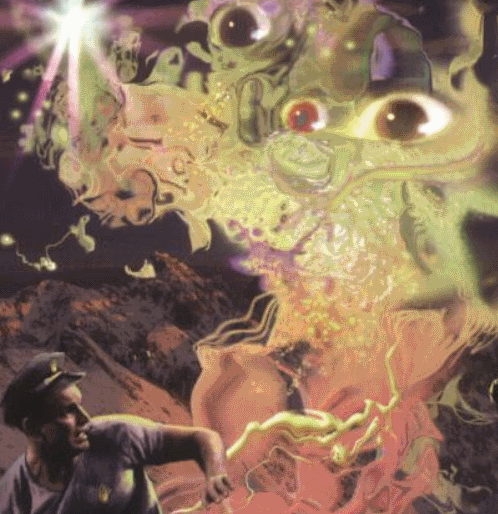
Palainians reside on super-cold planets - they have a small colony on Pluto - and breathe poisonous gases. They survive by having a metabolic extension into the fourth dimension and by being furtive, sneaky assholes. They have four sexes - "one," the prenuptial catalyst, "two," the protective/mother sex, "three," the aggressive/father sex, and "four," the postnuptial catalyst. Any can be Lensmen (even if you are playing Rude Sexist Lensmen) except "ones," mostly because "ones" are nearly immobile. Palainians are not physically intimidating and require powerful life support when in human-type environments, and use telepathy to communicate, as well as being callous, single-minded loners. They also have emergency teleport due to being partially fourth-dimensional entities. Being a shoggoth-ass motherfucker is 17 points on net, with a "one" being -33 (Sessile) and a "four" being 2 points (Combat Paralysis).
So, on to society. There is a brief note that the Boskonian cultural model involved complex overlapping and redundant networks of power and mutual observation, all of them ultimately flowing back to the dickbags on Eddore.
Civilization encompasses a huge variety of different planetary cultures. The Galactic Patrol hands most law enforcement/judiciary functions as well as military matters. There are some few oligarchies and monarchies, but the most common human-type government is some kind of planetary elected body. The Patrol enforces Civilization's basic laws on planets without legal codes, so "Anarchy" in a sense does not exist. There are also some Communist planets, although the traditional Steve Jackson running-dog rightist error claims "few humans take any of them seriously." Clear ether indeed, Lensman! 
The other "protagonist" species are simpler. Velantians are only on one planet and are heavily militarized and violent, even among themselves. Rigellians are happily and perfectly collectivist. Palainians are objectivists, as well as pathologically conflict-avoidant.
We get brief highlights on some other key facts. Leaving aside the cultural sexism, these beats are summarized with the four "protagonist" species in mind.
TAXES: Relatively low. The Patrol takes a small cut. Planets may assess more. The Patrol may veto "usurious" proposals. :thonk: Velantians and Palainains are a bunch of libertarian assholes who fund most things by use payments or contributions. Rigellians consider taxation esoteric due to communalism; Rigellian history has herds paying tribute to one another, and Rigel pays taxes as a planet, but it is not internally important.
PATRIOTISM, by which we mean SUPPORT FOR MILITARY ACTIVITY: Humans are always up for a war if they don't think it's immoral (realistic...) and the Boskonian threat is sufficient that volunteers fill Tellurian billets. Rigellians are also decent folk and will help out as soon as they are aware of a need. Velantians and Palainians are both libertarian assholes here too; Velantians do love fighting and murder, however, while Palainians hate it and will only cooperate when direly pressed.
LAW ENFORCEMENT: The Patrol mostly respects local laws, and attempting to leverage marginally superior technology to exploit a developing planet is a Galactic felony. Velantians and Palainians continue to be Hot and Cold Running Libertarians, with Rigellians being such absolutely collective folks that any individual Rigellian who offends is either mistaken (and will, of course, make up for it once educated) or is sufficiently organically damaged to get euthanized. Human law enforcement is similar to it is now (cops, jails) but the Lensmen have developed a sufficient reputation that criminal jurists are now all Lensmen and the jury system has withered away. Indeed, you can get put on the hook for crimes you weren't brought in for: the classic example cited is Solarian Union v. Ossman where the accused was arrested for littering in a national forest and executed for being a drug kingpin.

RELIGION: Lots of Earth religions survived, a lot of human-like religions have been adopted by Earthmen (see Klono above). Velantians continue to be tedious assholes. Rigellians have philosophical concepts similar to nirvana. Palainians have something surprisingly close to human religious beliefs but the concepts are so esoteric ("transcendental housework" or "technical poetry" are examples) that research is ongoing.
Next time we'll dig into some of the Advantages and Disadvantages baked up for this setting, one of the pleasures of any GURPS material.
Advantages and Disadvantages, Old and New
Original SA post"I rule Kyle insufficiently reverent to Klono! All Lenspaladin powers are LOST!"

III. Advantages and Disadvantages, Old and New
The Advantages/Disadvantages chapter begins with a stern warning that you don't have to be a Lensman to be cool and powerful. They do note that by the rules of the road in the setting, Lensmen have to have a certain set of powers, but you can still be a bad motherfucker and hang with Lensmen. Lensmen also get an extra goodie in that the Honesty, Sense of Duty, Code of Honor and Enemy (Boskonia) disadvantages don't count against the usual -40 points of Disadvantages limit.
Suggested tiers: 100 points - "Citizen of the Galaxy" - Just some motherfucker, probably rhapsodized over at length before your show is cancelled by Fox.
200 points - "Galactic Patrolman" - Cinematic heroic troops in the space war. Presumably this is where many of the recurring bridge-bunny characters in the novels are at.
400 points - "Lieutenant Lensman" - Relatively basic Lensmen and "heroic" Patrolmen. Ironically enough this still isn't enough points to play a Velantian or a Rigellian.
1,000 points - Unattached - If you really want to be a Gray Lensman, this is about where you start.
Much of this comical level of point inflation is due to a quirk of the GURPS system. Lensmen's power of execution is cheap, and their resources through the Patrol are mostly represented by Patrons or are just part of the campaign setting. (If you are in an army, GURPS doesn't make you pay for your gun.) Even psionic power levels don't soak up a ton of points. What does? SKILLS! And in the example characters, the Allies advantage, too.
An example: Kimball Kinnison, the protagonist of the 'main' Lensman stories, is presented as a 4,158 (!) point character. He has very high stats, certainly, but his main point sinks are over 500 points of skills (350+ in psionics) -- what good does it do you to have Telecontrol-35 in a system that has a 3D6 dice curve? (Answer: Kinnison can soak up a -17 penalty and still only fail on a 3.)
You also get a good example of how dumb the Allies advantage is. Kinnison's wife (herself a 3,000 point character) is worth 915 points due to appearing "all the time" - his three alien pals are also worth a cool thousand points, with his burly Valerian space marine buddy coming in at a mere 155 (all appearing "fairly often.") If the Lensman books' events were a GURPS campaign, all these people would be other PCs. This alone puts Kinnison down around 2,500 points, which, while not exactly "reasonable," is a ridiculous level of reduction.
Anyway, new stuff and modified stuff that's actually interesting:
Advantages: Magical aptitude doesn't exist. You can't get the Lensman level of super-elite Judge Dredd power without that good-good Lens. "The Release" is military rank 9 and funnily enough this means that, on net, being a Gray Lensman is a 25 point advantage. (-120 from being the personal enemy of Boskonia vs. 100 for Lensman + 45 for Military Rank 9) It might actually be negative given the mental disadvantages necessary to qualify.
New Advantages: Sense of Perception - "A practically perfect three-dimensional view of the entire circumambient sphere," including the inside of objects. You perceive shapes and if you are able to view colors with your eyes, you also view colors. (Rigellians have no light-perception organs, so sucks to be them.) Make an IQ roll minus the range in hundreds of miles to make out details. 100 points.
Alternate Identity: These are big in the books, usually backed by the Patrol's tentacles of Cop Force. An alternate identity is worth 15 points. A "temporary" identity is worth 0 points and is guaranteed to be good for a week. After that, roll 3d6. On an 8 or less, your fakes have been found out. On higher, roll again next week, adding 1 until you get made.
Unusual background: Second-stage stability. "Intrinsically stable at the second level of stress." Take fright checks at +20; you can learn advanced telepathic skills. In order to buy this you also usually have to buy...
Unusual Background: Exalted.
Here we get into a pretty fucked-up background detail. The Arisians have been engaging in selective breeding of intelligent life across the cosmos for aeons. To give an example of the scope, it is presented as having occured since the days of Homo erectus on Earth, and presumably comparable levels of scope in other planets. The Arisians are not nice people even if their ultimate goals are, at worst, "better than explicit slavery to Eddore or their subordinates."
UB: Exalted requires you to have ST, DX and HT at least one point and IQ at least two points above your species' average. Also, Longevity, Rapid Healing, Alertness +1 (or more), at least one level of Eidetic Memory, Intuition, Luck (ah, the Teela Brown theory of probability), Telepathy at power 3 or better, and at least 2 better levels of Strong Will than your species' average. (i.e. a Rigellian would be at worst Weak Will -2.) Since you are intended to be a leader, you also must have Attractive Appearance (by your species' lights) and Charisma +1, or better (on both fronts).
If your species has negative mental traits you have to buy them down at least one "level." (Rigellian Hidebound/Obdurate to, at worst, Incurious; Palainians lose Cowardice.) You can make up for this by being Fanatical about something, acquiring a -5 point Code of Honor (of some kind) and a -10 point Sense of Duty (also of some kind.) You may also have Overconfident, given your giant package of advantage over other jerks.
Being "Exalted" does not actually cost points above and beyond all that shit you have to buy. Thank Klono. Presumably various natural qualifications come up here -- for instance, Velantians and Rigellians all have Telepathy already.
If you have Second-Stage Stability, you can also buy Compartmentalized Mind - which is described awkwardly but is real easy to understand: You can run multiple instances of your mind in your brain. Each "instance" can do a psychic action (you need a different advantage to multi-task physically) simultaneously, so one level lets you do two, another three, etc. "Instances" have to use telepathy to inter-communicate, and third parties can eavesdrop on the telepathic activities. Only one instance can run the body at once - if they disagree, Contest of Wills roll! (The instance running the body gets a +1 in the roll.)
One good trick that can happen here is that you can let one of your mental instances succumb to psychic attack while the others watch. There is no real way to detect a compartmentalized mind from outside if it isn't telepathing the others.
Disadvantages: Most of the drugs the Boskonians smuggle are like comedy super-heroin and are really bad for you. Also, drugs are illegal, although if you are a mere retail user you are probably not headed for the lethal chambers. It is noted that if you are playing with a sexist Civilization, human women will have a -5 Social Stigma (Second Class Citizen).
New disadvantages: Appearance: Horrific indicates that your goony species happens to look exactly like some legendary evil for another species. The example here are Velantians, who look a lot like dragons. Innumeracy is present and given the lack of computer technology, is worth -10 points. "Free Sick" means you're gonna get puky when inertialess.
Skills: The main note is that Lensman uses a different and more granular "Tech Level" chart for purposes of technology skills. "Typical" stuff using transistors will make no sense, because Lensman shit uses "ultra-microminiature vacuum tubes."
Languages: Mental/Easy (Spaceal, a sort of spaceman's pidgin with technical precision and lots of swears), Mental/Average (Galactic Spanish, a Spanish dialect that a lot of aliens find easier than English)
Dexitroboping is a skill only critters with fourth-dimensional extensions can use, but it essentially lets you tuck in your 3-D parts and survive in vacuum for a while.
Mind Block lets you repeat Backstreet Boys songs in your head and guard against telepaths. Mental/Average. Anyone can learn it. Interestingly it is noted in the books that many people can't fucking stand having their mind read, and Lensmen don't consider that intrinsically suspicious... ...not least because many of them can overcome mental blocks if they *need to.*
Muscle Reading: Reading intentions through muscle mystery. Have some fun charts:

As you can see, Psionics is also not some profound mystery but is considered a physical science like any other.
At this point my preparatory material has come to its end... so I will seek input on what people would enjoy seeing next:
* Planets and Less Prominent Aliens
* Wacky Overpowered Psychic Crap
* Goofy Supertechnology (probably a multi-parter)
* Campaign advice -- which is one place where I think Barrett had some good ideas -- and no, it isn't anything grody, either
All of these will be visited in the fulfillment of the Cosmic All, no doubt...
Nels Bergenholm and the Weapons of Mass Destruction
Original SA post"What is it really that's going on here? You've got a system for total control"

IVa. Nels Bergenholm and the Weapons of Mass Destruction
In order to talk about the planets used as weapons, we first have to talk about the Bergenholm inertialess drive. (Named for its inventor, of course.) This widget, sized to a spacecraft or other object, activates and the object is then now "free" - of inertia. "An inertialess ship instantaneously takes on the velocity at which the force of her drive is exactly equalled by the friction of the medium in which she travels." (There is also a reactionless drive.)
This is the keystone faster-than-light drive in the Lensman setting, without which any of this bullshit would be so much irrelevant faffing about with super-psionics. The idea is that a "free" object can, in fact, exceed the speed of light if appropriately driven - especially in space. The speed of a spaceship is a matter of how powerful its power source and "jets" are, and how streamlined that ship is relative to the interstellar (or intergalactic) media.
This is one of the places where Smith thought everything through - or at least thought through the permutations of what it means for spaceships. For one thing it explains why everyone uses rays: an explosion or a hail of physical projectiles would, assuming nothing stopped the "free" ship, just knock it around. We will explore this in the section on ORDINARY weapons.

Now, what happens when the Bergenholm turns off? Good question. The object resumes its previous "intrinsic" velocity -- which is why most starships disable their Bergenholms well away from planets and "match intrinsics" with normal-space rocket/thruster motors. Small objects or personnel who have had to go inertialess get into "The Net," which is described in some detail as, literally, a gigantic spring-loaded shock absorber whose purpose is to let you dissipate your accumulated intrinsic velocity in a way that will either not hurt you, or will hurt you way less than smashing into a mountainside at .02 of lightspeed.
"Gee, Nessus," you may be thinking - "Wouldn't you be able to get a massive kinetic kill weapon this way?" You would be so able, yes. Given the permutations of this it was almost certainly tried - the main interfering points would be that there are faster-than-light sensors and extremely fast reactions, meaning that (for instance) someone who tried to take a comet free, park it over Prime Base, and turn off the Bergenholm would get shot down, or at least shot up enough that the Bergenholm would break down.
Gee... but what could handle that kind of rough treatment?
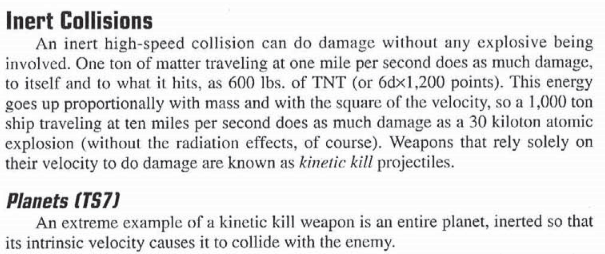
https://www.youtube.com/watch?v=lsV500W4BHU
Indeed. Though the first paragraph here outlines some of the challenge involved in kinetic kill weapons above and beyond the possibility of things being shot down: a "mere" 30kt explosion will not break a lot of the defense systems on static installations in this milieu.
Bergenholms will work for planets if you build out the installations... and the thrusters. If it's an empty planet, like Mercury or some dead rock in a lifeless solar system, there is no reason to worry about its long term fate... so what you do is that you find a planet with the right kind of intrinsic velocity, take it free, and then go park it in 'front' of the enemy planet. Even before the Bergenholms break down, there will be a hellacious impact.
Can the enemy take their planet free too? No problem: get two planets with more or less opposite intrinsic velocities and park them on either side. When their planet goes free, inert both of yours and watch the fireworks.
Is the enemy using a free planet as an invincible war-base a la Palpatine? No problem: make a negasphere! A negasphere is confusingly described by Smith, probably based on physical theories which became obsolete, but could be seen as "negative" matter.
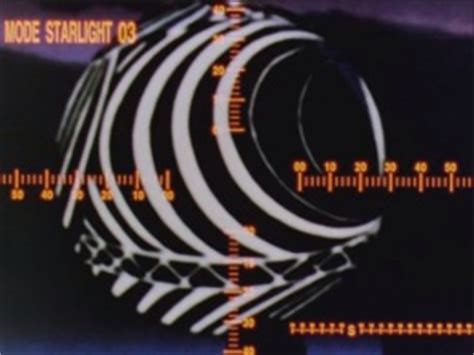
A scan of a negasphere as shown from the Patrol base, Hakone, Japan
However it works, a negasphere destroys a normal planet and liberates a huge amount of radiation. Be behind a screen or you're going to melt. This is actually not described as an explosion - great effort was taken to construct negaspheres approximately the same size as planet.
Ah, but perhaps you need to defend a planet with an ecosphere and you can't just flit it out of the way or use some kind of hellacious contraterrene matter that will sterilize everyone's buttholes for twenty light years around. Earth, for instance, or Arisia. That's cool: just build a sunbeam!

No biggie. Firing a Sunbeam requires a specialized Mental/Very Hard skill for the operators in order to hit their target. If their collective rolls succeed, the star dims dramatically and a massive-ass ray is released. On a failure, the star flares wildly and every planet in that system suffers a year - cumulatively, mind you - of exceedingly strange weather. On a critical failure, the star becomes permanently variable, which will soon render all but the hardiest and most adaptable life forms in that system extinct. If it was ALREADY variable, and you get ANOTHER critical failure, roll 2d: in that many days, the star will go supernova, obliterating its entire system and becoming a navigational hazard to shipping in the sector.
The ultimate weapons were planets from another universe with different velocity factors where Bergenholms still worked. The Patrol got there through theoretical guidance and VERY CAREFULLY kept everything in their gear "free" until they were able to build Bergenholms on the alien planet. They then, using a hyperspatial tube - we'll get to THAT later - they snuck it back into the "main" universe. The Patrol only used them once because they were, essentially, impossible to defend against -- and one of the recurring themes about technology in these books is that the other guy isn't stupid, and WILL use or copy anything of yours they can, if they have time.
You might fairly ask: How can you use this in a game?
My answer: I don't fucking know, but at least you have numbers to roll when Chewbacca gets hit by a moon.
Next time: Weapons of individual destruction! (Significantly more useful for gaming purposes.)
Weapons of Individual Destruction
Original SA post John Wick is a cover identity for Galactic Patrol officers investigating Boskonian money in politics, pass it on

The first entry is for DeLameters - which are actually a generic trademark for a particular style of energy pistol produced on Tellus, by "DeLameter Beam Weapons, Pty." (What the hell acronym is that for a company? Novel?)
It is never specified what kind of beam DeLameters shoot. They have three settings. Before we list these off in all their glory we will briefly summarize the damage output of several weapons from the GURPS 3E core rules. (Figures are per shot.)
Colt M1911 automatic pistol, .45: 2d damage, crushing
Disruptor, 6d damage, impaling
Keep in mind that the statistically average human being will have between 8 and 12 HP.

In a minor novelty, there is no giant fuckoff table of specific models of firearm or laser. DeLameters are presented as pretty much the best you're going to get in terms of a pistol. The "Lewiston" entries come from the First Lensman period; the M5 and M23 are slugthrowers, the M17 is also a beam. There are several clear reasons why the sacred and holy bullet have largely been abandoned by the main period of the book. One of these is inertialessness: a bullet would do no actual damage to an inertialess object. Another is the armor, which we will reach presently.
There is information on a "semi-portable," a integrated system that contains a beam weapon - a larger version of the DeLameter - a force screen and a grenade launcher, the latter being useful against armored-but-not-inertialess targets, or against things like bulkheads.
So there's no additional sort of super death ray - oh, wait -
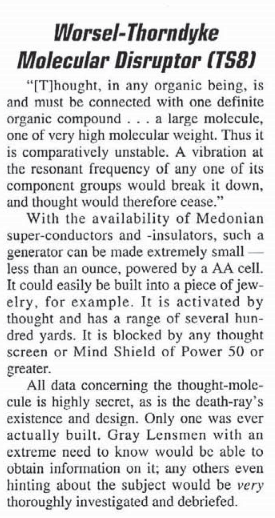
Oh.
Well, that sounds useful, doesn't it?
You may have noticed some "TS" figures here and there. This does not refer to secrecy levels, but is a sort of alternate, more granular version of the GURPS Tech Levels, a system meant to kind of sort of ballpark the distinctions in historical levels of technology. "Modern Earth" was usually put around TL7, although many a GURPS nerd annoyingly observed that various new discoveries were putting society into the realm of TL8. The Tech Stages (that's the TS, right there) are a clever idea, especially in the context of Lensman's "WWII in space" - WWII saw a lot of swift technical and engineering progress, by necessity. If you were creating a long-term space opera setting, or planning out something involving major long-running space war, making your own "Tech Stages" - even if only in thumbnail form - might be a quick way to add savor and flavor, as well as giving you hooks to toss to engineering/science types in the PC group.
There is armor. This is probably where the term "Space Marine" armor was first used. It does about what you would expect. The reason for these daffy huge ray gun numbers is because "light" space armor - basically a spacesuit with some reinforcement - has Passive Defense 3, Damage Resistance 10. The Space Marine armor has PD 4... and DR 75; plus 150, with some details, for the integral force-screen armor. (It's great against beams, less against physical attacks.) There is a special version for Valerians, which is DR 150 + 300 for the screen. Valerians are big beefy boys (and girls) and are often employed as shock troops.
Now what do you do if you've had your butt shot off by one of these lasers? Well... despite the author's prejudices, the books make it pretty clear that Civilization is able to give people cyborg rebuilds (in practice if not by name), and the medical corps is good enough that if you can crawl back to base alive, you'll survive. There is no nuanced detail about supplementary medications. Instead, there is Phillips Regeneration.
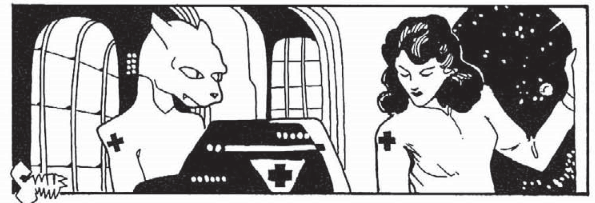
Invented by a Posenian (a four-armed species with the sense of perception; "Phillips" was the courtesy name of a physician), this system uses the sense of perception and medical radiation beams to stimulate the pineal gland. If the doctor fucks up, the subject develops malignant sarcomatosis and must make a HT check daily - for the rest of their life - because the first time they fail, they die!
The benefits are considerable. The subject gains Slow Regeneration - 1 HP per day, guaranteed - and the Regrowth advantage, which will allow missing limbs and members to come back, if slowly. There are no exceptions, requiring the removal of prosthetics etc. The new body parts are healthy but share the body's natural age and any intrinsic disadvantages (if you had Bad Sight due to natural causes, you still have it). New limbs require physical therapy. At long last - a treatment for infantile paralysis... polio!
Yes, some things do change.
This selection was certainly much lighter on torturous justifications for tired military-sci-fi misogyny and the absence of an intricate, tedious list of yet another goddamn dozen special-use firearms was a breath of fresh air.
Next time we will discuss Civilization's drug policy and list of prohibited substances, as well as other highlights of technology. From there, I intend to hit the bonkers psychic powers and the villain-driven GM system the author proposes - which was perhaps the most forwardlooking thing present. This is also the debut of the Space Opera Combat System which never thrilled me but may be of Interest to the F&F society.